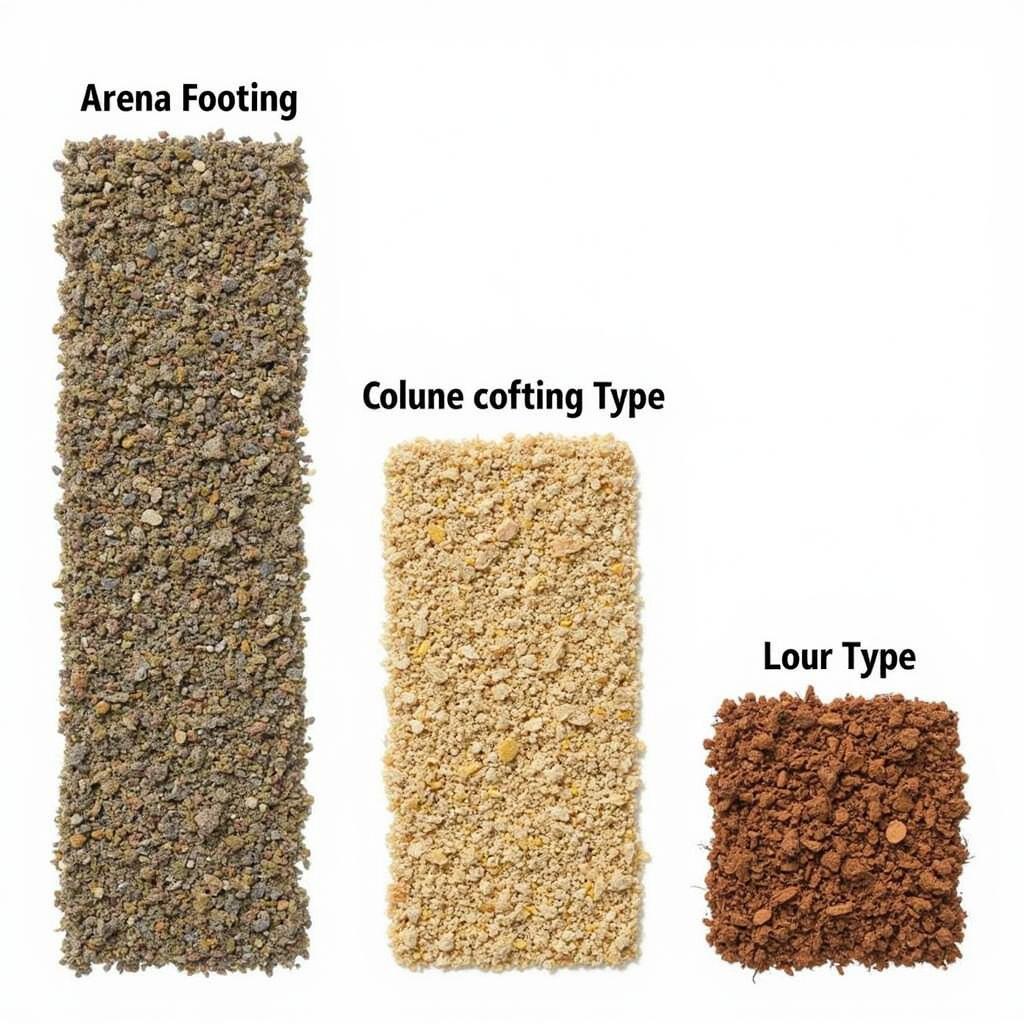Arena footing plays a crucial role in the health and performance of your equine athletes. Whether you’re training for competition or simply enjoying leisurely rides, the right footing can make all the difference. This comprehensive guide explores everything you need to know about Arena Footing For Horses, from understanding its importance to selecting the best materials and maintenance practices.
 Different types of arena footing
Different types of arena footing
Why is Arena Footing Important?
Proper arena footing provides a consistent and forgiving surface that supports your horse’s movement, reduces concussion on joints, and minimizes the risk of injury. Imagine running on a hard, unforgiving surface – your joints would ache, and you’d be more susceptible to strains and sprains. The same principle applies to horses.
Good footing contributes to:
- Soundness: Reducing strain on joints, tendons, and ligaments, leading to a longer and healthier athletic career for your horse.
- Performance: Providing the right amount of grip and cushion, allowing your horse to move freely and confidently, ultimately enhancing performance.
- Training: Creating a consistent and predictable surface that enables effective training sessions and skill development.
- Drainage: Preventing waterlogging and maintaining a usable arena year-round.
Types of Arena Footing
Choosing the right arena footing depends on your discipline, budget, and climate. Let’s explore some popular options:
1. Sand
Sand is a widely available and cost-effective option for arena footing. It provides good drainage and a relatively forgiving surface. However, not all sand is created equal.
- Considerations: The type of sand matters. Angular sand, with sharp edges, compacts well and provides better stability. Round sand, on the other hand, can become loose and dusty.
- Maintenance: Regular watering is crucial to prevent dust and maintain optimal moisture levels.
2. Rubber
Rubber, often derived from recycled tires, is a durable and resilient choice for arena footing. It offers excellent shock absorption and can be mixed with other materials like sand to enhance its properties.
- Benefits: Rubber footing is known for its longevity and low-maintenance requirements. It also provides good grip, making it suitable for a variety of disciplines.
- Considerations: The initial investment for rubber footing can be higher than sand, but its durability often offsets the cost over time.
3. Synthetic Footing
Synthetic footing is engineered using materials like geotextiles, fibers, and polymers. It offers a consistent and high-performance surface ideal for demanding disciplines.
- Advantages: Synthetic footing provides excellent drainage, requires minimal maintenance, and resists compaction. It’s also known for its cushioning properties, making it a top choice for high-impact activities.
- Considerations: Synthetic footing is typically the most expensive option, but its longevity and performance benefits make it a worthwhile investment for many riders.
 A side-by-side comparison of sand, rubber, and synthetic arena footing
A side-by-side comparison of sand, rubber, and synthetic arena footing
Factors to Consider When Choosing Arena Footing
- Discipline: The type of riding you do greatly influences the ideal footing. For example, dressage riders often prefer a firmer surface that allows for precise movements, while jumpers benefit from a more forgiving footing that cushions landings.
- Climate: Consider your local weather patterns. If you live in a rainy area, prioritize footing with excellent drainage. In dry climates, dust control becomes a key consideration.
- Budget: Arena footing materials vary widely in cost. Determine your budget early on to narrow down your options.
- Horse’s Needs: Consider your horse’s age, breed, and any pre-existing conditions. Older horses or those with joint issues may benefit from a more cushioned surface.
Maintaining Your Arena Footing
Proper maintenance is essential for maximizing the lifespan and performance of your arena footing.
- Regular Raking and Leveling: Distribute the footing evenly and remove any debris or clumps.
- Watering: Maintain optimal moisture levels, especially for sand arenas, to minimize dust and ensure good compaction.
- Professional Maintenance: Consider periodic professional maintenance, such as deep tilling and dragging, to address compaction and ensure the footing remains level and safe.
Expert Insights
“Investing in quality arena footing is an investment in your horse’s well-being and your own riding experience,” says renowned equine veterinarian Dr. Emily Carter. “Don’t underestimate the impact of a good surface on your horse’s longevity and performance.”
Conclusion
Choosing the right arena footing is paramount for the health, well-being, and performance of your equine partner. By understanding the different types of footing, considering your specific needs, and implementing a regular maintenance routine, you can create an optimal riding environment for you and your horse.
Remember, a well-maintained arena translates to happy horses and enjoyable rides.
FAQ
1. How often should I rake my arena?
Ideally, rake your arena after each riding session to redistribute the footing and remove debris.
2. How can I tell if my arena needs watering?
If the footing is dusty or you can easily make a deep indentation with your foot, it’s time to water.
3. Can I mix different types of arena footing?
Yes, many riders combine materials like sand and rubber to achieve the desired properties.
4. How long does arena footing last?
The lifespan varies depending on the type of footing, usage, and maintenance.
5. Should I consult a professional for arena footing installation?
Yes, a professional installer can ensure proper grading, drainage, and material selection.
Have more questions? Need help choosing the right footing for your arena?
Contact us today! Our team of experts at Justus Horses USA is here to provide personalized guidance and support.
Phone: 0772127271
Email: [email protected]
Address: QGM2+WX2, Vị Trung, Vị Thuỷ, Hậu Giang, Việt Nam.
We offer 24/7 customer support to answer all your arena footing and equine care needs.